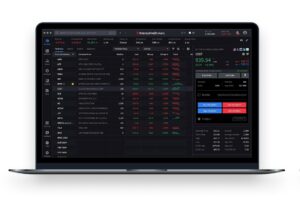The Dow Jones (US30) was up 1.23% on Thursday. The S&P 500 Index (US500) added 2.03%. The Nasdaq Technology Index (US100) was up 2.79%. The US stocks rose on Thursday, posting gains for the third straight session, as technology shares led gains and investors weighed mixed signals from the Trump administration on tariffs and trade talks with China. Hopes for a Federal Reserve rate cut also strengthened after the Cleveland Fed president said there could be action in June if supported by data.
The Mexican peso strengthened to 19.6 per US dollar, hitting its highest level in six months, helped by the general weakening of the US dollar and expectations of a continued hawkish stance by the Bank of Mexico. Mexico’s wide real rate differential continues to attract robust carry-trade inflows, while a “very productive” conversation between Presidents Trump and Sheinbaum eased concerns over potential US tariffs. In addition, stable oil export revenues support Mexico’s external accounts.
Equity markets in Europe were mostly up on Thursday. Germany’s DAX (DE40) rose by 0.47%, France’s CAC 40 (FR40) closed 0.27% higher, Spain’s IBEX 35 (ES35) fell by 0.22%, and the UK’s FTSE 100 (UK100) closed 0.05% yesterday. European stock indices reversed early losses and closed higher on Thursday, recording three consecutive days of gains, helped by a positive session on Wall Street. Despite this, the German government lowered its economic growth forecast 2025, predicting stagnation instead of 0.3% growth, citing ongoing global uncertainty caused by trade tensions.
The US natural gas prices (XNG/USD) fell to $2.9/MMBtu, the lowest in five months, amid lower gas prices in major European and Asian centers amid oversupply and uncertain demand due to macroeconomic factors. The new data showed that gas production in the lower 48 US states rose to 106.6 billion cubic feet per day in April, a record high. This coincided with warmer-than-normal temperatures, which are expected to persist through early May, reducing demand for gas-intensive heating.
Asian markets were predominantly rising yesterday. Japan’s Nikkei 225 (JP225) gained 0.49% yesterday, China’s FTSE China A50 (CHA50) climbed 0.35%, Hong Kong’s Hang Seng (HK50) declined 0.74%, and Australia’s ASX 200 (AU200) closed 0.60%. China has begun issuing special bonds to guard against rising trade tensions. Beijing also cut its list of sectors negative for foreign investment from 117 to 106, signaling a desire to further open up the market.
The New Zealand dollar slid to around USD0.598 on Friday but remained on track for a third straight weekly gain amid optimism over trade talks between the US and China. Earlier this week, Trump hinted at softening his aggressive trade stance toward China, New Zealand’s largest trading partner, by proposing significantly reducing tariffs on Chinese imports. Domestically, expectations of further monetary easing by the Reserve Bank of New Zealand continue to weigh on the currency. Markets remain focused on a 25bp rate cut at the RBNZ’s May meeting, with rates likely to reach the 2.75% level by year-end.
On Friday, the Australian dollar dipped below US$0.64, trimming gains from the previous session as the US dollar strengthened on signs of easing global trade tensions. On the domestic front, data released earlier this week showed that Australia’s private sector activity rose for the seventh consecutive month in April, thanks to strong growth in both manufacturing and services. Despite the positive economic data, the Reserve Bank of Australia is expected to cut the policy rate by 25 basis points again in May as the country prepares for the potential economic impact of the recently imposed US tariffs.









